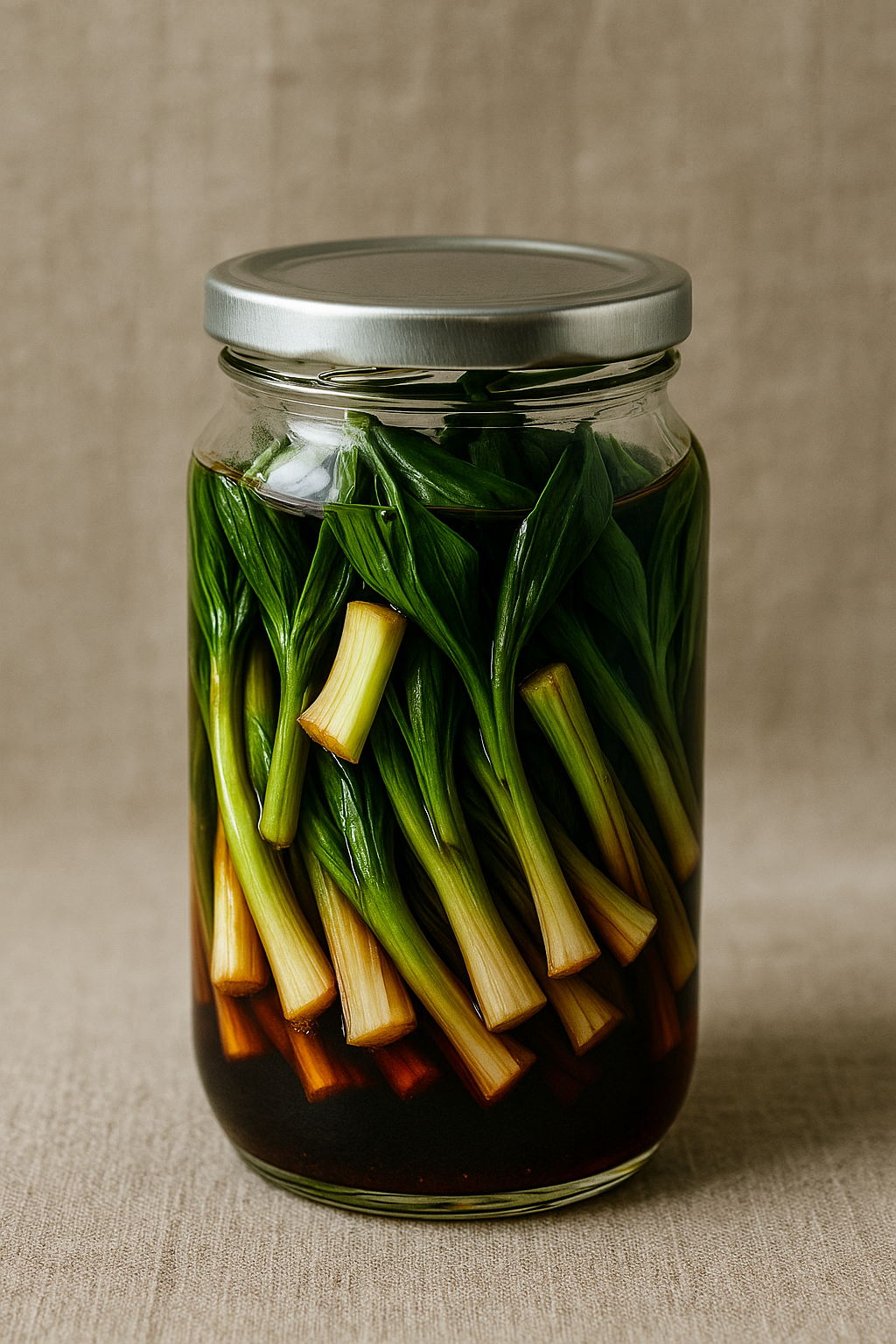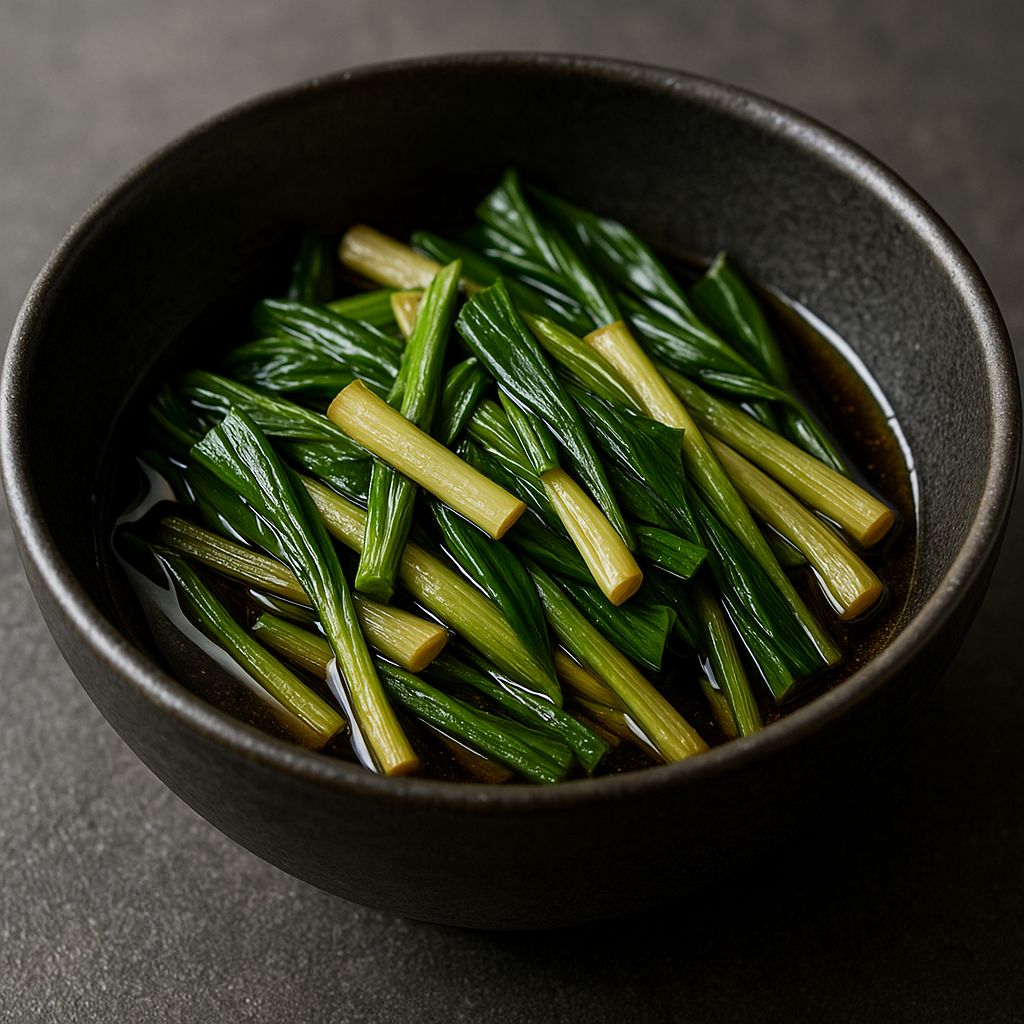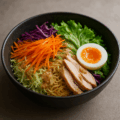
行者にんにくの醤油漬けの特徴
北海道の山菜料理
行者にんにくは、北海道を代表する山菜のひとつで、春にしか採れない貴重な食材です。独特の香りと強い風味が特徴です。
醤油漬けで長期保存
新鮮な行者にんにくを醤油に漬け込むことで、風味を活かしつつ保存性を高めます。季節の味覚を長く楽しめる方法として親しまれています。
万能な調味料にも
醤油漬けはご飯のお供だけでなく、冷奴や焼肉、パスタの風味付けなど幅広い料理に活用できます。
行者にんにくの醤油漬けのレシピ
材料(2〜3人分)
- 行者にんにく … 200g
- 醤油 … 200ml
- みりん … 大さじ2
- 酒 … 大さじ2
作り方
- 行者にんにくを水で洗い、根元を切り落とす。
- 熱湯でさっと下茹でし、冷水にとって水気をしっかり絞る。
- 保存容器に並べ、醤油・みりん・酒を加えて漬け込む。
- 冷蔵庫で一晩以上置けば完成。
シェフのワンポイントアドバイス
漬け込みは3日以上すると味がより染み込み、保存性も高まります。醤油が濃いと感じる場合は少し水で薄めても良いでしょう。
又は小さく刻んで炒め物や何かのトッピングにしても良いでしょう。
行者にんにくの醤油漬けの栄養価(1人分の目安)
- エネルギー:約30〜50 kcal
- たんぱく質:1〜2 g
- 脂質:0〜1 g
- 炭水化物:5〜8 g(調味料由来)
- ビタミンC・βカロテン(行者にんにく由来)
- アリシン(にんにく特有の成分で血流改善効果)
低カロリーながら滋養強壮効果が期待され、スタミナ食材としても知られています。
行者にんにくの醤油漬けの歴史
山菜文化の一部
北海道や東北では春に山菜を採取して保存する文化があり、行者にんにくの醤油漬けもその一環として作られてきました。
修行僧と行者にんにく
名前の由来は、山で修行する行者が精をつけるために食べたことにあります。滋養強壮に優れた山菜として古くから重宝されてきました。
郷土料理から観光食へ
現在では北海道の特産品として瓶詰めや土産物としても販売され、観光客にも人気があります。
English Version
Features of Soy-Pickled Alpine Leek (Gyoja Ninniku)
Mountain Vegetable Cuisine of Hokkaido
Gyoja ninniku (alpine leek) is one of Hokkaido’s signature wild vegetables. Harvested only in spring, it is prized for its distinctive aroma and strong, pungent flavor.
Longer Keeping by Soy Pickling
Pickling fresh alpine leek in soy sauce preserves its flavor while extending shelf life, allowing the taste of the season to be enjoyed longer.
Also a Versatile Condiment
Beyond eating it as a side for rice, the pickle works as a condiment for chilled tofu, grilled meats, pasta, and many other dishes.
Recipe for Soy-Pickled Alpine Leek
Ingredients (2–3 servings)
- Alpine leek (gyoja ninniku) … 200 g
- Soy sauce … 200 ml
- Mirin … 2 tbsp
- Sake … 2 tbsp
Instructions
- Wash the alpine leek and trim the root ends.
- Blanch briefly in boiling water, chill in cold water, then squeeze out excess moisture.
- Arrange in a clean container and pour in the soy sauce, mirin, and sake.
- Refrigerate for at least one night before serving.
Chef’s Tip
Letting it pickle for 3 days or more deepens the flavor and improves keeping quality. If the soy flavor feels too strong, dilute the brine slightly with water. You can also finely chop the pickles and use them in stir-fries or as a topping for various dishes.
Nutritional Value (per serving, approx.)
- Calories: 30–50 kcal
- Protein: 1–2 g
- Fat: 0–1 g
- Carbohydrates: 5–8 g (mainly from seasoning)
- Vitamin C, β-carotene (from alpine leek)
- Allicin (garlic-derived compound that supports circulation)
Low in calories yet known as a stamina-boosting food with potential tonic effects.
Historical Background
Part of Foraged Mountain-Vegetable Culture
In Hokkaido and Tohoku, there is a tradition of foraging spring mountain vegetables and preserving them; soy-pickled alpine leek developed within this culture.
Linked with Ascetic Monks
The name “gyoja ninniku” (“ascetic’s garlic”) is said to come from monks who ate it in the mountains as a source of strength; it has long been valued for its tonic properties.
From Local Fare to Souvenir Food
Today it is produced as a regional specialty, commonly sold in jars as a popular Hokkaido souvenir.



何でも質問してください!